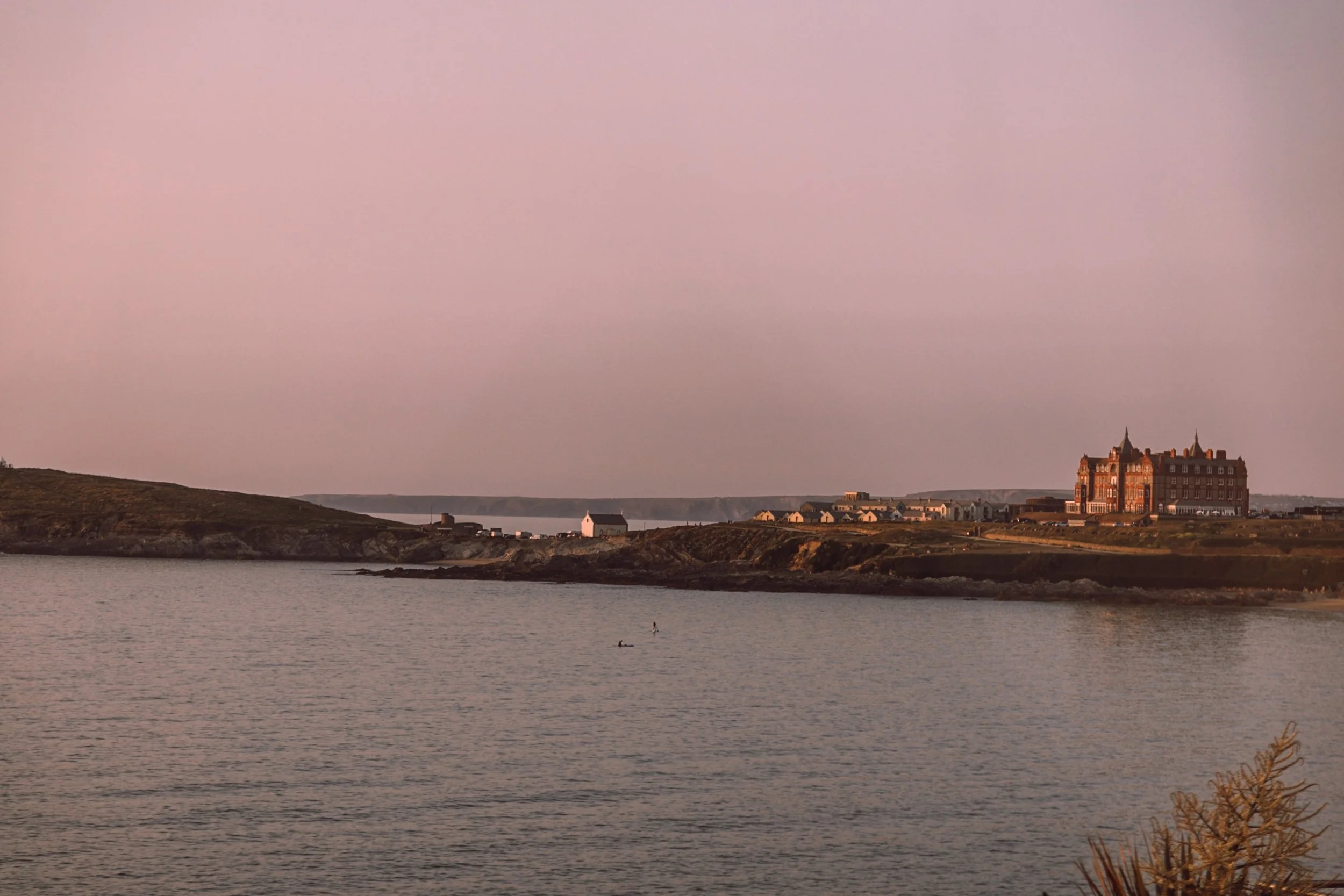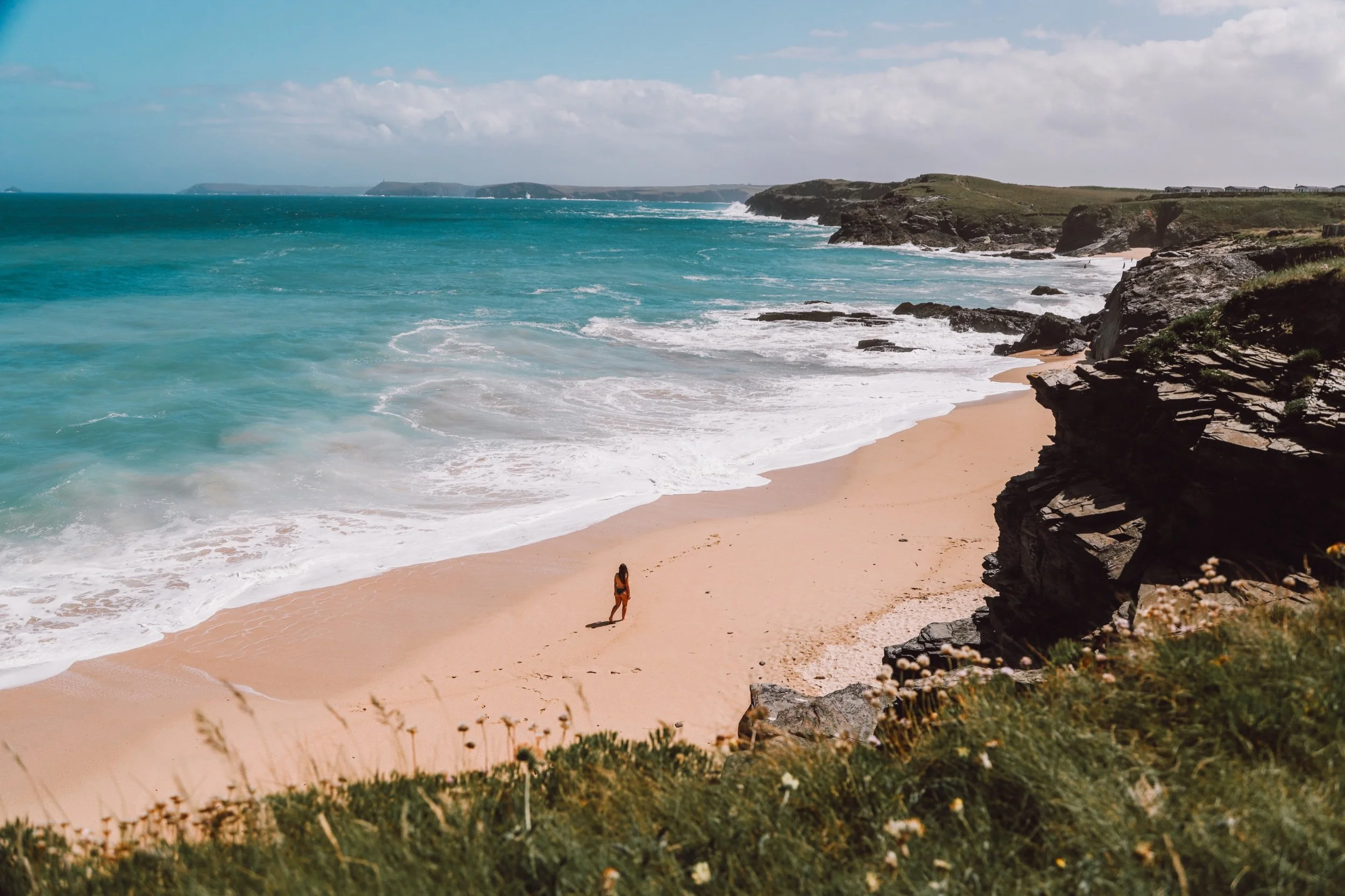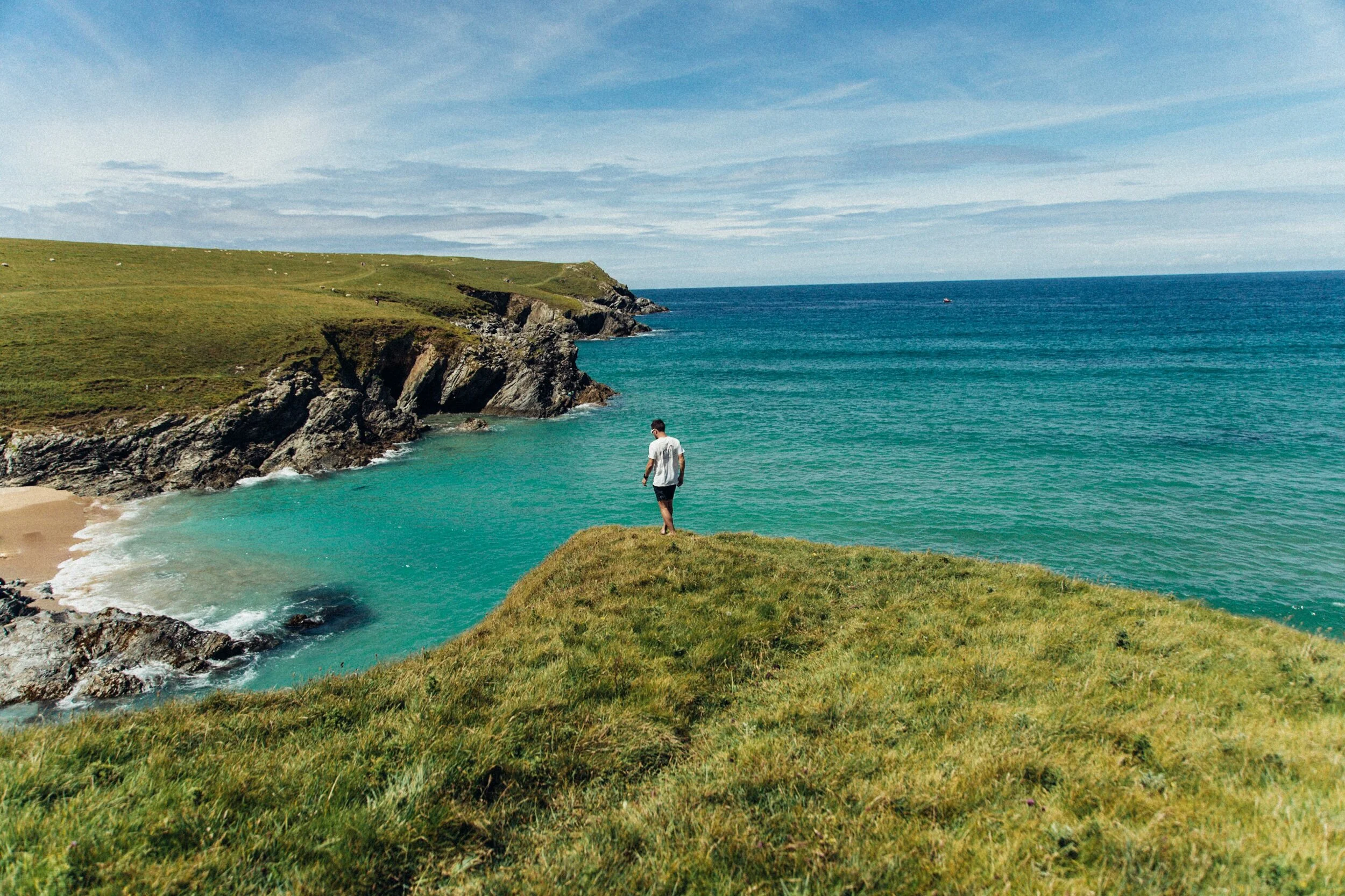The rugged coast of Cornwall is steeped in natural beauty, and the north coast is famous for its surfing beaches, one of our favourite ways to explore the coast is by campervan. A trip to the coast has been a popular pastime for centuries and has many benefits, getting in the ocean for a quick dip has proven to improve your mood and have multiple health benefits.
An ever-growing outdoor swimming community seeks regular opportunities to get outside to do ‘wild swimming’, which simply refers to swimming in the natural environment such as rivers, lakes and the ocean.
When swimming in the ocean in the UK, we don’t have to worry about great white sharks. The only threats we face are strong rip currents and stormy weather which can make swimming a risky activity, especially in the colder months, when there aren’t any lifeguards on duty.
A solution to year-round swimming is tidal pools, these are outdoor swimming pools that are either manmade or natural pools that are only accessible during low tide. Cornwall has more than 33 tidal pools dotted along its coastline, making wild swimming safer and accessible to everyone.
This guide will list some of the best tidal pools in Cornwall, most of which you can enjoy for free and we will share how to access them to help you plan your next adventure. If you’re looking for a comprehensive guide to beaches in Cornwall then read our list of the 35 best beaches in Cornwall.
How are tidal pools formed?
Tidal pools, also known as natural swimming pools, sea pools, or lidos are formed when seawater fills up in a pool during high tide, this is when water from the ocean reaches its highest point up the beach. As the tide changes, the seawater will retrace its path back away from the beach during low tide leaving seawater in the pool and exposing a wonderful swimming spot.
The popularity of swimming in the ocean was realised in the Victorian era when many tidal pools were built as safe places for children and adults to swim in seawater, without the worry of currents or rogue waves. Swimming in cold seawater was discovered to have multiple health benefits. During the Industrial Revolution, a trip to the seaside was a welcome change from the smog of the cities and was prescribed by doctors as a remedy, including getting plenty of fresh sea air.
The coast became much more accessible after the construction of the extensive network of railways across England, connecting the cities to the seaside. Tidal pools and lidos were built usually using concrete, and the rocks were dug out to create areas where seawater would stay, creating the perfect tidal pool. These tidal pools are secret treasures and are special features of our coastlines that allow us to connect to the past and nature.
What are the benefits of cold water swimming?
After the realised benefits of cold water swimming in Victorian times, there has been a recent surge of interest in outdoor swimming and research on the benefits since the COVID-19 pandemic. When access to indoor swimming pools and gyms was restricted from 2019 to 2020, many resorted to the great outdoors for their dose of swimming, as a welcome distraction from the stresses of the pandemic.
There is a long list of benefits of cold water swimming from improving blood pressure, boosting your immune system, increasing circulation, relieving stress and anxiety, promoting better sleep and can also reduce inflammation.
How to access tidal pools?
When planning to swim in a tidal pool, there are a few things to consider beforehand. Most importantly safety comes first, do not swim alone and make sure you do not take any risks. Some tidal pools in this list may require a short hike or scramble and you must not do it if you feel uncomfortable and make sure you know your limits.
Access to tidal pools is limited to a period of usually a few hours on either side of low tide, depending on the tides. Make sure to check the tide times before setting off on your adventure. Give yourself plenty of time and you may have to wait for the tide to retreat before swimming in the pool, take a seat, enjoy the scenery and watch nature change right before your eyes. Keep your eye on the time whilst enjoying your swim to ensure you don’t get cut off by the tide.
Many tidal pools are not signposted and require a bit of navigation, which is all part of the adventure. A quick search on Google Maps satellite view or Google Earth can give you a better idea of their exact location and this guide will share instructions for each. Be careful when entering and leaving tidal pools, they can be slippering and rocky underfoot.
Do not jump unless you are certain about the depth of the pool, tidal pool depths can vary with the sea washing in and out twice a day, bringing in sand and stones. It can also be difficult to see the bottom of the pools and know the depths, so make sure to be careful when jumping in.
What essentials should you bring for tidal pool swimming?
Swimsuit or wetsuit
Perhaps the most essential item to bring is a swimsuit or wetsuit, wear one that is well-made and close to your skin to keep you warm. If you plan on going for a longer swim or you haven’t swam in cold water before it’s worth bringing a wetsuit. My preference is a spring suit that covers my arms but not my legs, allowing me to move with ease is my choice after after a well-fitted swimsuit.
Changing robe or towel
A slight upgrade from the humble towel is a warm cosy changing robe, that is very convenient and avoids the accident slip of the towel whilst trying to put your underwear on! Of course, a towel will do if you don’t have a changing robe, but it has the double benefit of keeping you covered whilst getting changed and keeping you warm.
Hat
A warm woolly hat or swimming hat will help keep your head warm. Most of your heat is lost in your head, so keeping it covered with a hat will keep you warmer for longer.
Gloves
A pair of neoprene gloves is great if you feel cold easily or have poor circulation. They will keep you warm during cold dips and aren’t necessary in the summer months.
Change of clothes
Make sure to pack a lovely warm fleece, base layers and trousers that are easy to get on and comfortable. Avoid wearing jeans as they are not very good at retaining heat and when wet can keep you cold. Wear joggers or tracksuits and when you get out of the pool it’s best to put your trousers and socks on first.
Socks or shoes
Neoprene socks add an extra layer of protection to your feet when walking on rocks in tidal pools which can be sharp and uncomfortable. Neoprene shoes have a rigid rubber sole and are great for a bit of extra grip and keep your feet warm.
Hot water bottle or hand warmers
In chilly months, it can take your body longer to warm up after a cold water swim. A way to help your body warm up before and after is having a hot water bottle with you or hand warmers for an extra boost of warmth.
Hot flask of your favourite drink
In addition to the hot water bottle, don’t forget your favourite hot drink that you can have to look forward to after your swim and warm you up if you experience the after drop. The after drop is when your body gets out of the water and you can feel suddenly cold for around 30 minutes afterwards which is also why it is important to bring the next thing on the list!
Snacks
Bring a snack to enjoy after your swim, this ensures that you can get your energy back after your swim. Shivering uses a lot of energy and you’ve more than earned it!
Goggles
If you want a more immersive experience, bring goggles or a snorkel to discover the underwater world of tidal pools and the other sea life and plants that also enjoy its waters.
What’s it like to swim in a tidal pool?
If you plan to swim in a tidal pool, it's really important to know your limits and never push yourself. Slowly emerging into the water allows your body to regulate its temperature and also control your breathing. It takes time for our bodies to adapt to their new environment and everyone's tolerance to cold differs.
Be aware of how you feel, changes in your body temperature and if you get cramp, feel hot or weak get out of the water. It’s worth staying near the edge to begin with and see how you feel. Swimming in tidal pools can be good fun, you’ll likely meet like-minded people who love to swim and be outdoors.
When you get out of the water you may experience the ‘after drop’, this is when your body temperature continues to drop once you get out of the water. It can last around 30 to 40 minutes and makes your body feel colder than when you were in the water. This is why it's important to have warm clothing, snacks and a hot drink to help recover your body temperature.
BUDE SEA POOL, SUMMERLEAZE
Bude Sea Pool is a large tidal pool located on the north coast of Cornwall on Summerleaze Beach offering a great swimming experience for everyone. With easy access to the sea pool from Bude, it has charming coastal views and can be enjoyed no matter the weather.
The Bude Sea Pool was constructed in the 1930s, where a concrete wall was built along the shorefront surrounded by rocks to create a semi-natural pool perfect for safe swims by the ocean in salty seawater.
It is free to visit and solely relies on members of the public and volunteers to maintain and look after the pool, currently managed by Friends of Bude Sea Pool. There are no toilets or other facilities by the pool, so ensure that you bring everything with you that you’ll need for your swim.
How to get to Bude Tidal Pool | The nearest car park is Summerleaze Long Stay Car Park which has public toilets and is a pay and display car park. Access to the Bude Tidal Pool is a short walk from the car park and can either be from the beach or the South West Coast Path.
CHAPEL ROCK TIDAL POOL, PERRANPORTH
The unique Chapel Rock tidal pool is in Perranporth and shaped like a coffin from above. Perched up against the impressive backdrop of Chapel Rock, it stands isolated in the middle of Perranporth Beach, decorated with the Cornish flag standing as a signal beacon for wild swimmers to enjoy its tidal pool.
The clear waters reveal a thriving ecosystem of colourful sea creatures, making it a haven for snorkelers and nature enthusiasts. Timing your swim at sunrise or sunset can make for a special and unique experience. When the tide rolls in Chapel Rock is cut off and once you’ve finished your swim, head for a drink at The Watering Hole, the only licenced beach bar in the UK.
How to get to Chapel Rock Tidal Pool | The nearest car park is the Promenade car park which has a height barrier of 2.13 metres and is a pay and display car park. You will be able to see Chapel Rock with the Cornish flag (black and white cross) from the car park and access to the beach is over the bridge towards the Summerhouse.
TREYARNON BAY TIDAL POOL, Padstow, Cornwall
Located on the north coast of Cornwall, the Treyarnon Bay tidal pool is between Padstown and Mawgan Porth and is one of the most accessible tidal pools. Perched on top of rocks on the northern edge of the beach, the Treyarnon Bay tidal pool is a good size and ideal for families with easy access from the South West Coast Path and at low tide from the beach.
Treyarnon Bay Beach is a wonderful, sheltered cove with golden sand with nearby facilities including a café, convenience store and public toilets. A firm favourite destination in the summer for many, anticipate sharing this beautiful tidal pool with a few other enthusiastic swimmers!
How to get to Treyarnon Bay Tidal Pool | Park in Treyarnon Bay Car Park at the end of the road that leads to the beach. It is a large pay and display car to the north of the beach and next to the Caravan Park. Follow the coastal path from the car park, past the toilets and the tidal pool will be on your left.
TREVONE BAY TIDAL POOL
The beautiful Trevone Bay tidal pool is located west of Padstow and is locally referred to as Tinker Bunny’s Bathing Pool. A quiet haven and the ideal place for a sunset dip when synced with low tide, Trevone Bay tidal pool was created by building concrete sea walls at two ends of the pool.
Surrounded by beautiful black Cornish slate, the tidal pool was recently repaired in 2013 to restore the sea walls. The tidal pool is large in size and the local area has a lovely intimate feel, without the feeling of being too when compared to other spots in Cornwall. Trevone Bay is a wonderful sheltered sandy cove with a surf shop, outdoor sauna, café and scenic walks along the coast, making it an ideal place to visit.
How to get to Trevone Bay Tidal Pool | There is a small car park opposite Trevone Bay which is pay and display overlooking the beach and is the perfect place to watch sunset. To reach Trevone Bay tidal pool you will take the coastal path to the southwest, with Trevone Bay on your right as you walk along the path.
Eventually after a short 5 minute walk, you will reach the tidal pool on your right, there is a scramble down over slate rocks and the pool is visible from the path at low tide. Alternatively, park in the Well Parc Hotel and walk through the fields towards the coast to reach Trevone Bay tidal pool.
PORTHTOWAN Tidal pool
Hidden in between the cliffs at Porthtowan Beach, this extraordinary tidal pool is man-made and one of the smaller tidal pools mentioned in this list so far. Porthtowan tidal pool was built in 1908 and has a concrete sea wall that holds the water back at low tide. A little more difficult to access as a result of its secret location, you could easily walk past the pool on the beach without realising it was right next to you.
How to get to Porthtowan tidal pool | The nearest parking is Porthtowan Council car park which is pay and display and Porthtowan tidal pool is located on the eastern side of the beach adjacent to the tall cliffs.
The best way to access the tidal pool is a couple of hours before low tide from the beach to the north of the tidal pool which makes it the simplest way to locate it. You can also access the beach from the south, however, you will have to scramble over many rocks to get there which can be a bit more challenging and is more of an adventure!
There used to be access from the surrounding cliffs, but the path has eroded and is no longer stable or safe to reach from this direction. We would highly recommend taking some good shoes with you to scramble over the rocks.
Mermaid Pool, Kynance Cove
This has to be one of the most stunning beaches in Cornwall and word about its beauty has spread far and wide. The golden sands and crystal clear waters make it a lovely setting for a swim. The Mermaid Pool is a hidden gem and is a magical tidal pool in Kynance Cove and best visited on a calm day.
It is worth noting that the beach can get cut off from the path at high tide, make sure to check the tide times before you set off on your adventure. Kynance Cove is a popular spot in summer and is worth timing your visit out of the summer season, or early in the morning or later in the day to avoid the crowds.
How to get to Mermaid Pool in Kynance Cove | Park in the National Trust Kynance Cove car park (free for NT members) and walk along the path towards the cove that will take around 15 minutes downhill. Only take the swim essentials mentioned earlier and pack light as it is quite a walk to the beach.
Walk along the path until you reach a pebbly beach and continue towards Asparagus Island which is straight ahead. Follow the beach around the headland where you’ll find a hidden sandy beach next to the rocky outcrop of Asparagus Island which is only accessible at low tide. The mermaid pool is hidden among rocks and located just below the cliffs, a great place to jump into its deep waters from the rocks!
If you enjoyed this article pin it to read later
This post may contain affiliate links, which means if you purchase through these links, we may receive a small commission at no cost to you. Thank you for supporting our website.







































